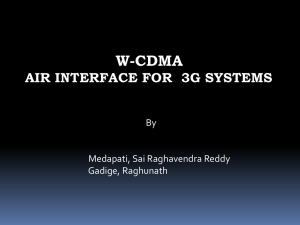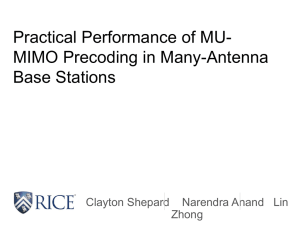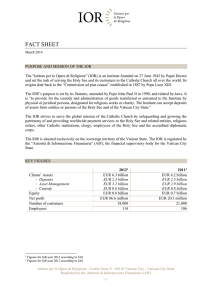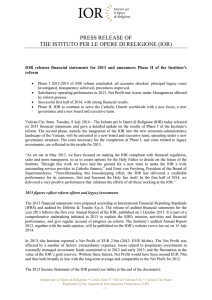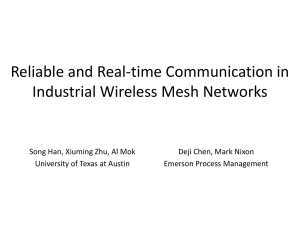WCDMA Capacity ()
advertisement
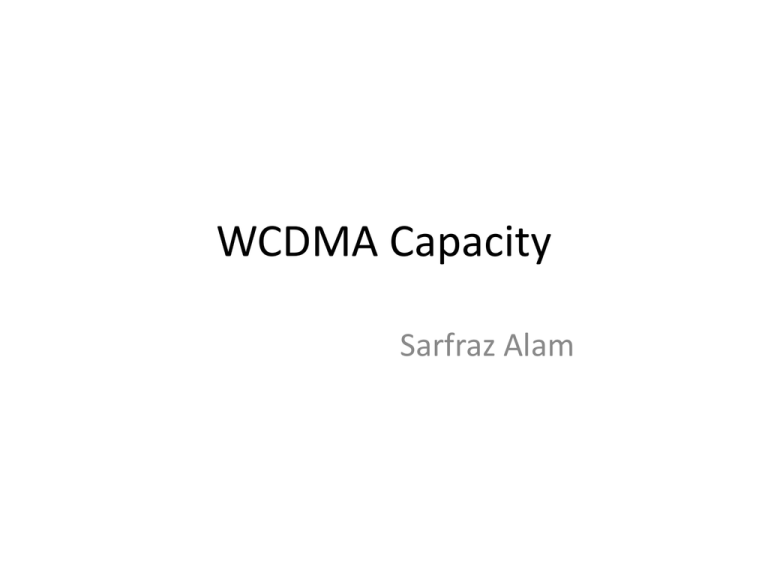
WCDMA Capacity Sarfraz Alam WCDMA Overview • Based on wideband Direct Sequence Code Division Multiple Access (DS-CDMA) • Uses 3.84Mcps chip rate that leads to a carrier bandwidth of approximately 5MHz • Supports highly variable user data rate • Supports two basic modes of operation: frequency division Duplex (FDD) and Time Division Duplex (TDD) • Designed to deploy in conjunction with GSM Factors Affecting the Capacity • Desired coverage • Orthogonal variable spreading factor (OVSF) code limitation • Soft handover impact • Adjacent Cell interference • Target Signal to Noise Ratio (Eb/Nt) • Traffic to total Power ratio Ec,DPCH / Ior • etc Selected Papers 1. ESG Quallcom, “Air Interface Cell Capacity of WCDMA System” [http://www.qualcomm.com/common/documents/w hite_papers/Air_Interface_Cell_Capacity__RevB_new. pdf] 2. T. Griparis, T. M. Lee, “The Capacity of WCDMA Network: A CASE STUDY” [http://www.utdallas.edu/~cpb021000/shared/pdfs/0 000001.pdf] Mobility Channel & User Traffic for Capacity Estimation • Channels - static channel, Case 1 (3km/hr), Case 2 (3km/hr with random mean power 0dB), Case 3 (120km/hr) • User Traffic - Speech: radio bearer 12.2kbps UL/DL - Packet Data: 64 kbps UL/64, 144kbps DL Release-99 Cell Capacity • Assigned dedicated physical channel (DPCH) for each call to carry traffic • Cell-capacity: maximum simultaneous DPCHs assigned within WCDMA cell Uplink Cell Capacity • Upper bound of the uplink capacity referred as pole capacity • Pole capacity can be estimated using the standard uplink capacity equation. W Rb Npole eq1 Eb * v * 1 Nt Uplink Cell Capacity • From pole capacity, practical cell capacity can be calculated using uplink loading factor (η). Eb UL W No * N * v * 1 Rb Nuser Npole * Signal of user J Eb / No j proces sin g gain of user j* total received power Eb / No j Solving for Pj Pj 1 1 w .Itotal Lj 1 1 w Eb / No j . Rj .Vj N N j 1 j 1 Pj Lj *Itotal Pj Noise Rise .... eq 2 Itotal PN u sin g eq2 Noise Rise Itotal PN 1 N 1 Lj 1 1UL j 1 considering int erference ratio by putting value ofNpole and η .... eq 1 Eb / No j . Rj .Vj Pj Lj * Itotal Itotal eq 2 w Pj . vj . Rj Itotal Pj UL 1 . N N j 1 j 1 1 Lj 1 . other cell int erference own cell int erference 1 w Eb / No . Rj .vj for voice service network wh ere all N user in the same cell have a low bit rate of R Nuser N W Eb / No . R .v 1 Simplified version UL Eb / No * N *v*1 W R Uplink Cell Capacity for Voice Service • Example: - Assuming uplink loading factor 75%, and target Eb/No 5.1dB calculate pole capacity. using eq2: Eb W No 5.1dB 3.3 R 3.84 _*10 6 314 12.2*10 3 v0.6 1 1 0.6 1.6 u sin g eq 2 0.75 N 76 3.3*0.6*1.6*N 314 Uplink Cell Capacity for Voice Service Npole W Eb Nt Rb * v * 1 eq1 AWGN Case 1 Case 2 Case 3 Target Eb/Nt 5.1dB 11.9dB 9dB 7.2dB Pole capacity 101 21 41 62 75% loading capacity 76 16 31 47 60% loading capacity 60 12 24 37 Uplink Cell Capacity and Throughput for PS 64kbps W Rb Npole is measured eq1 • Cell capacity for PS data in terms Eb * v * 1 Nt of the aggregated cell data throughput TP Nuser * dataRate * 1 BLER AWGN Case 1 Case 2 Case 3 Target Eb/Nt 1.5dB 6.2dB 4.3dB 3.4dB Pole capacity 27 9 14 17 75% loading capacity 20 7 10 13 60% loading capacity 16 5 8 10 Pole Throughput 1.7Mbps 0.6Mbps 0.9Mbps 1.1Mbps 75% loading throughput 1.3Mbps 0.4Mbps 0.7Mbps 0.8Mbps 60% loading throughput 1.0Mbps 0.3Mbps 0.5Mbps 0.7Mbps Downlink Cell Capacity • Downlink cell capacity can be estimated using downlink pole capacity equation. Npole 1 oh *W Rb Eb * v * Ioc Nt I or Downlink Cell Capacity for Voice service AWGN Case 1 Case 2 Case 3 Target Eb/Nt 5.1dB 13.4dB 10.8dB 7.8dB Pole capacity 299 30 32 94 75% loading capacity 239 24 26 76 - Interference factor is assumed 0.3 - voice activity factor is 0.6 - overhead channel power percentage is 25% - orthogonality factor varies from 0.1(AWGN) to 0.7(Case2) Downlink Cell Capacity using Ec,DPCH Nuser , downlink 1 oh v * Ec , DPCH Ior • Expected DPCH power depends on the target Eb/Nt and power control margin Downlink Cell Capacity using Ec,DPCH for Voice Service Eb W Ec, DPCH I or * * Ior Ioc Nt Rb AWGN Case 1 Case 2 Case 3 Maximum Ec,DPCH / Ior -16.6dB -15.0dB -7.7dB -11.8dB Adjusted Ec,DPCH / Ior -22.6dB -11.0dB -15.7dB -19.8dB 226 16 46 119 Capacity Nuser , downlink 1 oh v * Ec , DPCH Ior Downlink Cell Capacity using Ec,DPCH for PS Data Rate 64kbps AWGN Case 1 Case 2 Case 3 Maximum Ec,DPCH / Ior -13.6dB -13.9dB -6.4dB -8.1dB Adjusted Ec,DPCH / Ior -19.1dB -9.9dB -14.4dB -16.1dB 61 7 21 31 3.9Mbps 0.5Mbps 1.3Mbps 2.0Mbps Capacity Throughput Downlink Cell Capacity using Ec,DPCH for PS Data Rate 144kbps AWGN Case 1 Case 2 Case 3 Maximum Ec,DPCH / Ior -9.9dB -10.6dB -8.1dB -9.0dB Adjusted Ec,DPCH / Ior -15.9dB -6.6dB -10.1dB -11.0dB 29 3 8 9 4.2Mbps 0.5Mbps 1.1Mbps 1.4Mbps Capacity Throughput • The maximum cell throughput decrease as DPCH data rates increase foe case2 and case 3 Conclusion • Eb/Nt plays a vital role in determining the WCDMA Cell Capacity • Lower the Eb/Nt, higher the cell capacity • Loading factor becomes 1, noise rise approaches to infinity • Increased in cell geometry by X dB requires decrease in Ec,DPCH / Ior by X dB • Capacity is very sensitive to mobility channel
